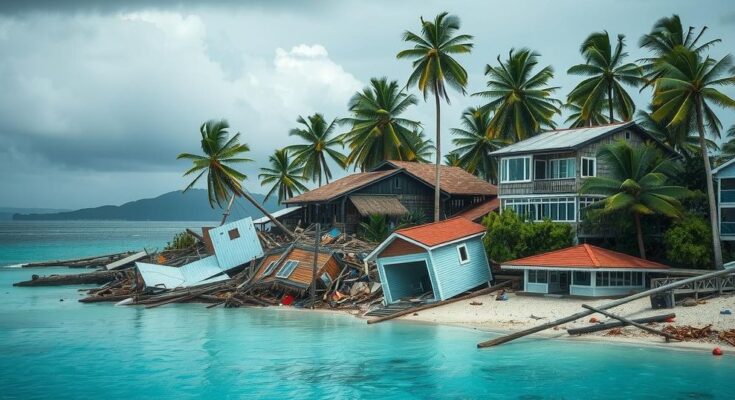Cyclone Chido, a Category 4 storm, has devastated Mayotte, leading to at least 35 confirmed deaths and widespread destruction, including neighborhoods, schools, and healthcare facilities. Emergency aid is being provided by European nations, while the need for transitioning to renewable energy becomes increasingly evident in the wake of climate-related disasters.
Cyclone Chido, classified as a Category 4 tropical storm, wreaked havoc on the French archipelago of Mayotte in December, marking the most devastating storm to impact the region in ninety years. This powerful cyclone, with winds reaching 136 miles per hour, has tragically claimed the lives of at least 35 individuals, with officials anticipating that this toll may rise as assessments continue. The cyclone obliterated neighborhoods, destroyed schools, and hospitals, leaving two-thirds of the island’s inhabitants cut off due to widespread power outages and damage to communication networks.
The situation in Mayotte has raised significant alarms, not only for the profound immediate impacts but for the long-term implications of climate change in the region. Previous to Cyclone Chido, Mayotte was substantially affected by Cyclones Idai and Kenneth in neighboring Mozambique, with extensive damage and substantial human loss. Given the projections from the French Development Agency, increased vulnerability to extreme weather events may define the archipelago’s future as climate change continues to progress further.
In response to this humanitarian crisis, emergency aid has been mobilized by the European Commission, as numerous countries, including Belgium, Germany, Italy, and Sweden, have stepped forward to provide assistance. The EU’s Copernicus Emergency Management Service has delivered valuable mapping resources to support relief efforts in both Mayotte and Mozambique, with nearly $1 million allocated for emergency humanitarian aid to Mozambique focusing on water, shelter, and healthcare resources.
This calamity highlights the pressing need for a transition to renewable energy sources, as the exacerbation of extreme weather conditions can be traced back to climate change and the emission of harmful gases. With advancements in solar, wind, and hydropower technologies, there exists tangible hope for mitigating the impacts of future weather catastrophes.
Cyclone Chido has emerged as a stark reminder of the catastrophic potential of tropical storms in a climate-changed world. Mayotte, an archipelago situated between Madagascar and Mozambique, has historically been susceptible to extreme weather. Recent storm events, including Cyclones Idai and Kenneth, underscored the region’s vulnerability, with significant loss of life and property. As noted by various organizations, ongoing climate changes contribute to the increasing intensity and frequency of such hurricanes, profoundly affecting this fragile ecosystem. Furthermore, the responses initiated by European nations and the EU highlight an urgent call to address these climatic threats through immediate aid and long-term strategies aimed at promoting sustainability.
In conclusion, Cyclone Chido has drastically impacted Mayotte, marking one of the worst natural disasters in the region’s recent history. The loss of life and destruction caused by the cyclone reinforces the urgent need for effective climate action and disaster preparedness in vulnerable areas. As nations rally to provide much-needed assistance to those affected, it is imperative to integrate sustainable practices that mitigate the impacts of climate change on future weather events. The dedication of various countries and organizations to assist the victims underscores a collective responsibility to protect fragile communities from the uncertainties of a changing climate.
Original Source: www.thecooldown.com




